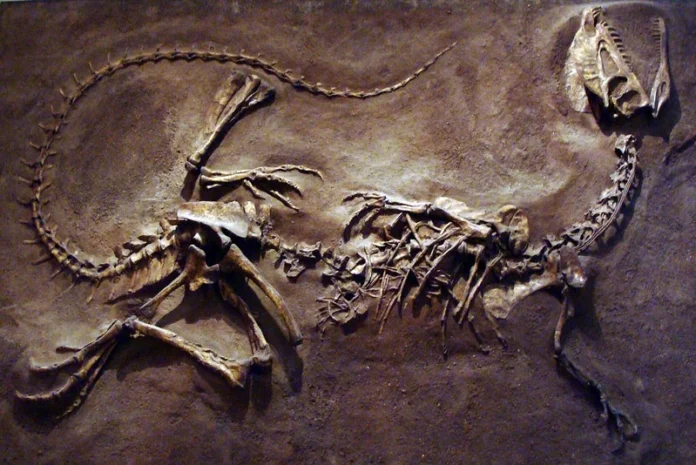Scientists have unearthed in Arizona fossils of a group of animals, including North America’s oldest-known flying reptile, that speak of a period of transition when old lineages soon to be extinct existed side by side with newcomers in early days of the age of dinosaurs.
The pterosaur fossil, roughly the size of a small seagull, and the other creatures were discovered in Petrified Forest National Park, famous for making fossils of plants and animals of the Triassic Period like giant tree trunks. The newly found fossils are 209 million years old and include at least 16 species of vertebrates, seven of which were previously unseen.
The Triassic succeeded the Earth’s greatest mass extinction 252 million years ago and ended with a further mass extinction 201 million years ago that had wiped out many of the dinosaurs’ major competitors, which achieved unchallenged hegemony during the subsequent Jurassic period. Both catastrophes clearly were instigated by cataclysmic volcanism.
The fossils, which are entombed in rock laden with volcanic ash, provide a glimpse of a lush tropical environment where rivers incised the south edge of large desert.
Along with the pterosaur were other newcomers to the scene including primitive frogs, lizards like reptiles and one of the earliest known turtles – all alike their modern relatives. The largest meat-eaters and herbivores in this environment were from reptile lineages that dominated at the time but later went extinct not very long after.
Although the Triassic marked the dawn of the dinosaur era, there were no dinosaurs present in this environment, demonstration just how far off dinosaurs still were from becoming dominant.
Although dinosaurs appear in Arizona and New Mexico contemporaneous rocks, they weren’t a part of this ecosystem we were studying, “said paleontologist Ben Kligman of the Smithsonian Institution’s National Museum of Natural History in Washington, lead author of the study published in the journal Proceedings of the National Academy of Sciences.”.
This is strange, and perhaps has to do with dinosaurs liking to inhabit other kinds of environments,” Kligman said.
This environment was located just north of the equator in the center of the ancient supercontinent called Pangaea, which later split apart and formed the modern continents.
Pterosaurs, cousins of the dinosaurs, were the first vertebrates to have powered flight, followed subsequently by birds and bats. Pterosaurs probably evolved around 230 million years ago, around the same time as the earliest dinosaurs came into existence, but their oldest known fossils dated back around 215 million years ago in Europe.
The pterosaur that was found recently, known as Eotephradactylus mcintireae, is thought to have fed on fish in the nearby streams. Its partial skeleton includes part of the toothed lower jaw, some additional isolated teeth and the bones of its long fingers, which were added to its wing system.
It had a wingspan of around three feet (one meter) and its skull was about four inches (10 cm) long. It had curved fangs at the front to catch fish as it swooped over water and blade-like teeth at the back of the jaw to chop down prey. Eotephradactylus would have had a tail, all the earliest pterosaurs did, scientists said.
Eotephradactylus is “ash-winged dawn goddess,” in reference to the rock type in which it was found and the position of the species at the beginning of the pterosaur family. Mcintireae is named in honor of Suzanne McIntire, the former Smithsonian fossil preparator who found it.
The turtle was a land-dwelling species while the lizard-like reptile was cousin to New Zealand’s current Tuatara. Also found were fossils of some other reptiles including armored plant-eaters, a huge fish-eating amphibian and other fishes like freshwater sharks.
The biggest predators of the food web were relatives of the crocs perhaps 20 feet (six meters) in length and larger than the meat-eating dinosaurs that dominated that part of the world. Land had a four-legged meat-eating reptile belonging to the rauisuchian group. Rivers had a semi-aquatic carnivore belonging to the phytosaurs, constructed somewhat like a crocodile but with some variations, like nostrils at the top of the head instead of the end of the snout.
Rauisuchians, phytosaurs and a number of other lineages found in the fossil record perished in the end-Triassic extinction event. Frogs and turtles made it to the modern time, but pterosaurs dominated the skies prior to the asteroid collision 66 million years ago that ended the dinosaurs’ dominion.
“The site marks the transition towards more modern terrestrial vertebrate faunas,” Kligman said.



